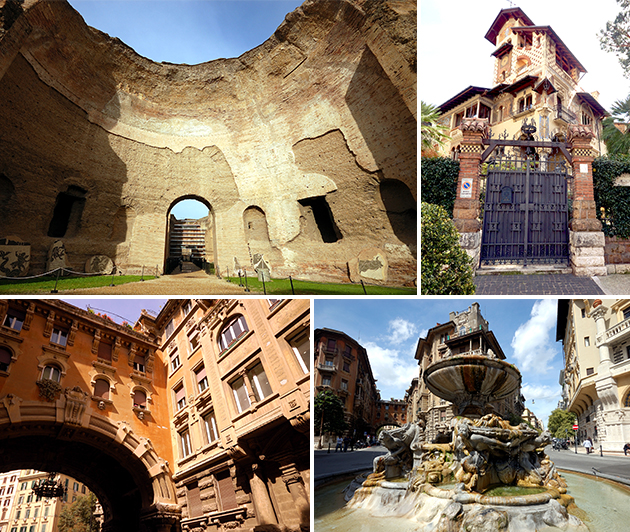
Rome is such a popular tourist destination that everything has been seen and done — at least that’s what most people think. Who hasn’t tossed a coin in the Trevi Fountain with the hope to come back to the Eternal City? Or explored the Vatican? Michelangelo’s ceiling of the Sistine Chapel is possibly one of the most iconic sites reproduced in guidebooks worldwide. However, the Italian capital has a lot to offer off the beaten path. Here are a few of Rome’s best overlooked sites:
Baths of Caracalla
Emperor Caracalla’s idea of what the spa experience should be like is a precious insight into Romans’ knack for la dolce vita that has bedazzled artists, writers and visitors for centuries. Despite being close to the Colosseum, the Baths of Caracalla often go unnoticed — undeservingly so, since they make for a unique peek into ancient Rome’s leisure time and hydraulic expertise.
Built between 212 and 219 A.D., the baths, or Thermae Antoninianae, retain much of their original imperial flavor after nearly 1,800 years. Historical research tells us about wonderful decorations, Oriental-style floors with colored marble, walls covered with glass mosaics, paintings, huge marble pillars and hundreds of statues in the main areas and gardens. Today, we get a glimpse into the past, thanks to the mosaics and floor pieces left despite centuries of neglect — they are among the biggest and best-preserved ancient thermal baths.
Not only can you see the space devoted to fitness and wellbeing, such as the gym, sauna and spa rooms, but also the areas allocated to study and leisure time, Romans’ true specialty.
San Paolo Fuori le Mura Basilica
Second in size only to Saint Peter’s, San Paolo Fuori le Mura Basilica is often overlooked probably due to its location outside the immediate city center. However, the most adventurous, or simply curious, won’t be disappointed by this majestic piece of Christian architecture.
After Constantine’s Edict of Milan of 313 put an end to the persecution of Christians, a small church where Saint Paul was martyred in 67 A.D. was built — his grave already the place of pilgrimage among the faithful. When the church became too small and unable to receive the growing stream of pilgrims, it was replaced with a new, bigger basilica. Built in byzantine style, San Paolo Fuori Le Mura consists of one large central nave and two aisles on each side sustained by a forest of 80 granite monolithic pillars.
Renovated and embellished by different popes throughout the centuries, the basilica is the awe-inspiring result of layers of historical periods and art movements — from the mosaics and paintings commissioned by Pope Leo the Great in the 5th century to the new Chapel of the Crucifix, which Pope Benedict XIII built for the Jubilee of 1725. A devastating fire in 1823 destroyed much of the original basilica, but it was gradually rebuilt reproducing as much of the original look as possible.
Catacombs
Apart from those in the city center, such as the Priscilla ones on Via Salaria and Sant’Agnese on Via Nomentana, most catacombs lie a bit far from the usual tourist areas. This is probably why tourists often replace a visit to Saint Callixtus on Via Appia Antica with something easier to reach. Fair enough, you could say, except that what you are missing out on is a paramount piece of early Christian history.
Mistakenly considered the place where Christians used to hide from early persecutions, the catacombs were actually their first cemeteries, and only occasionally were used as a hideout to perform religious functions.
Covering 90 acres, with a network of galleries about 12 miles long and some 66 feet deep, Callixtus’ are among Rome’s largest and most important catacombs. Named after deacon Callixtus, allocated by the pope to manage what soon became the city’s official cemetery, these catacombs have been the final resting place for dozens of martyrs, 16 popes and many Christians, including Saint Cecilia, patron of musicians, belonging to a wealthy Roman family and martyrized in the 3rd century. She was buried and worshiped here until 821, when her relics were moved to Trastevere, at the basilica devoted to her.
Quartiere Coppedè
Unknown to most tourists — and many locals — the Coppedè neighborhood doesn’t even feel like Rome. Not far from Piazza Fiume and the boutiques lining Via Salaria, this dreamy district is accessible through a heavily decorated arch and beneath a cast-iron chandelier. As soon as you spot the huge chandelier, you’ll feel like tiptoeing into this small quarter. At times like a fairytale-like, other times disquieting, the unique neighborhood was designed by Florentine architect Gino Coppedè in the early 1900s.
A captivating mix of pagan and Christian features sits side-by-side adorning palaces and mansions, and different architectural styles — from Liberty to Baroque, and art deco to classical elements —blend in untethered to time or place. Façades embellished with paintings, sculptures, columns and balconies make this neighborhood extremely photogenic.
For even more secrets to traveling in Rome, visit with Markus Dobritzhofer, chef concierge at Rome Cavalieri, Waldorf Astoria Hotels & Resorts.
Photos Courtesy of Angela Corrias

